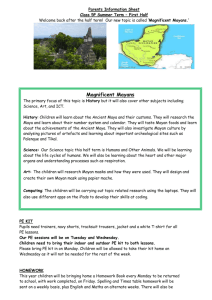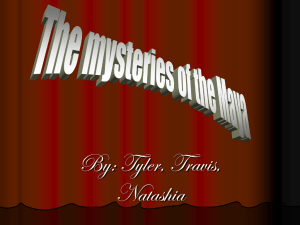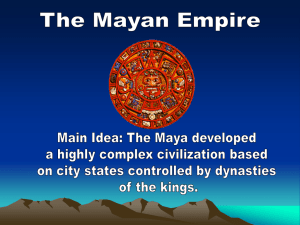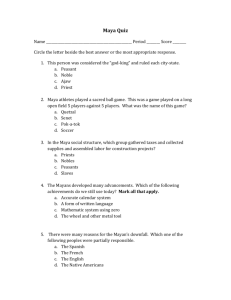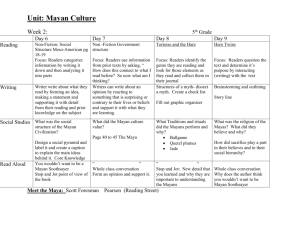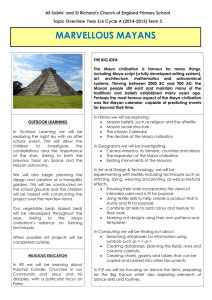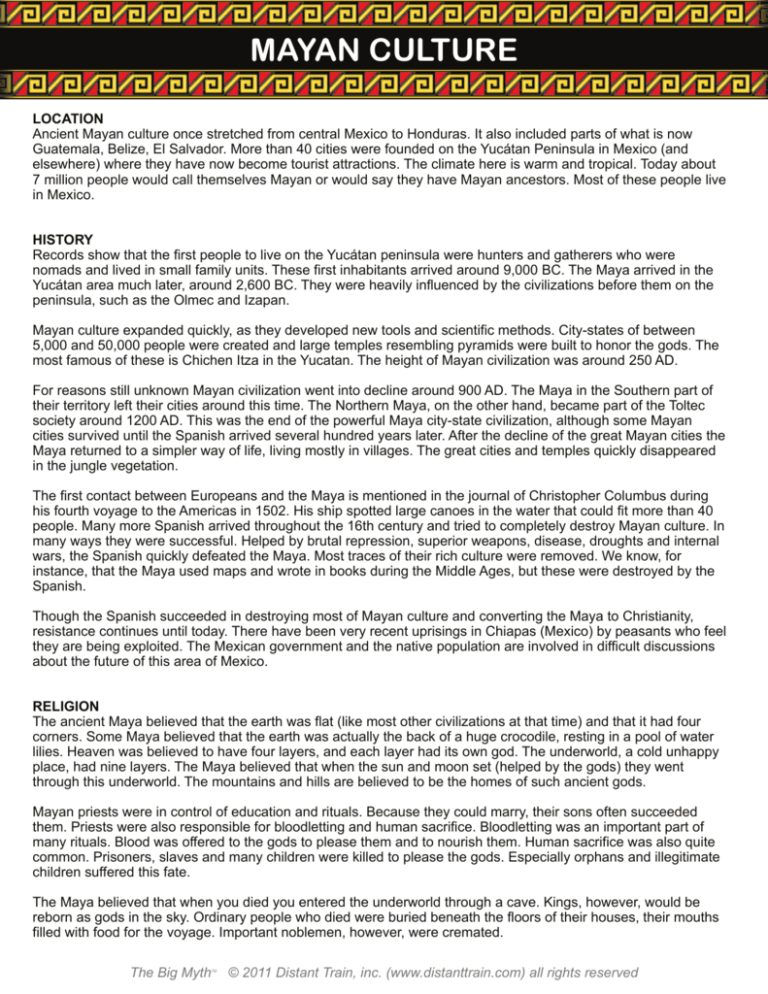
MAYAN CULTURE
LOCATION
Ancient Mayan culture once stretched from central Mexico to Honduras. It also included parts of what is now
Guatemala, Belize, El Salvador. More than 40 cities were founded on the Yucátan Peninsula in Mexico (and
elsewhere) where they have now become tourist attractions. The climate here is warm and tropical. Today about
7 million people would call themselves Mayan or would say they have Mayan ancestors. Most of these people live
in Mexico.
HISTORY
Records show that the first people to live on the Yucátan peninsula were hunters and gatherers who were
nomads and lived in small family units. These first inhabitants arrived around 9,000 BC. The Maya arrived in the
Yucátan area much later, around 2,600 BC. They were heavily influenced by the civilizations before them on the
peninsula, such as the Olmec and Izapan.
Mayan culture expanded quickly, as they developed new tools and scientific methods. City-states of between
5,000 and 50,000 people were created and large temples resembling pyramids were built to honor the gods. The
most famous of these is Chichen Itza in the Yucatan. The height of Mayan civilization was around 250 AD.
For reasons still unknown Mayan civilization went into decline around 900 AD. The Maya in the Southern part of
their territory left their cities around this time. The Northern Maya, on the other hand, became part of the Toltec
society around 1200 AD. This was the end of the powerful Maya city-state civilization, although some Mayan
cities survived until the Spanish arrived several hundred years later. After the decline of the great Mayan cities the
Maya returned to a simpler way of life, living mostly in villages. The great cities and temples quickly disappeared
in the jungle vegetation.
The first contact between Europeans and the Maya is mentioned in the journal of Christopher Columbus during
his fourth voyage to the Americas in 1502. His ship spotted large canoes in the water that could fit more than 40
people. Many more Spanish arrived throughout the 16th century and tried to completely destroy Mayan culture. In
many ways they were successful. Helped by brutal repression, superior weapons, disease, droughts and internal
wars, the Spanish quickly defeated the Maya. Most traces of their rich culture were removed. We know, for
instance, that the Maya used maps and wrote in books during the Middle Ages, but these were destroyed by the
Spanish.
Though the Spanish succeeded in destroying most of Mayan culture and converting the Maya to Christianity,
resistance continues until today. There have been very recent uprisings in Chiapas (Mexico) by peasants who feel
they are being exploited. The Mexican government and the native population are involved in difficult discussions
about the future of this area of Mexico.
RELIGION
The ancient Maya believed that the earth was flat (like most other civilizations at that time) and that it had four
corners. Some Maya believed that the earth was actually the back of a huge crocodile, resting in a pool of water
lilies. Heaven was believed to have four layers, and each layer had its own god. The underworld, a cold unhappy
place, had nine layers. The Maya believed that when the sun and moon set (helped by the gods) they went
through this underworld. The mountains and hills are believed to be the homes of such ancient gods.
Mayan priests were in control of education and rituals. Because they could marry, their sons often succeeded
them. Priests were also responsible for bloodletting and human sacrifice. Bloodletting was an important part of
many rituals. Blood was offered to the gods to please them and to nourish them. Human sacrifice was also quite
common. Prisoners, slaves and many children were killed to please the gods. Especially orphans and illegitimate
children suffered this fate.
The Maya believed that when you died you entered the underworld through a cave. Kings, however, would be
reborn as gods in the sky. Ordinary people who died were buried beneath the floors of their houses, their mouths
filled with food for the voyage. Important noblemen, however, were cremated.
The Big Myth
TM
© 2011 Distant Train, inc. (www.distanttrain.com) all rights reserved
Maya traditional religion survives until today, but now contains many elements of the Christian faith. Nevertheless,
many Mayans today believe, as the original Mayans did, in the influence of the cosmos and the need to pay
homage to the gods through rituals. The sun is now associated with the Christian belief in God and Jesus Christ
and the moon with the Virgin Mary.
SOCIETY, ECONOMY AND POLITICS
The Mayan world consisted of many city-states that shared language, religion and customs. On the whole,
despite ritualistic human sacrifices, their culture seemed to be less violent and more artistic than other large
civilizations of this period.
The ancient Maya used what is called a "slash and burn" technique to clear a forest and to establish agriculture.
This allowed them to stop migrating and develop cities. Their main crops were maize, beans, beans, squash and
tobacco. Mayan society was arranged according to a strict hierarchy. Nobles and kings had a great deal of power,
as did priests. Slave ownership was quite common.
Trade was an important feature of Mayan society. The Mayan used the Caribbean to connect one part of their
empire to other parts. Around 300 BC the Maya started setting up a large system of trade over water (also using
rivers), and developed many sea routes. For centuries after that period in time there were wealthy merchants who
used large canoes to trade a variety of goods, such as salt, animal pelts, feathers, cacao, gold, honey, cloth,
knives, etc. The merchants even had their own god and protector (Ek Chuah). Those who are descended from
the Maya find themselves a minority throughout Central America, and have been
RELIGION
The ancient Maya believed that the earth was flat (like most other civilizations at that time) and that it had four
corners. Some Maya believed that the earth was actually the back of a huge crocodile, resting in a pool of water
lilies. Heaven was believed to have four layers, and each layer had its own god. The underworld, a cold unhappy
place, had nine layers. The Maya believed that when the sun and moon set (helped by the gods) they went
through this underworld. The mountains and hills are believed to be the homes of such ancient gods.subject to
much political repression. They are also quite often poor, with few rights. Many Mayans today do not have access
to good health care or education.
Many Maya from Guatemala have also had to flee the country as refugees during the last decades due to civil
wars and conflict. Thousands have died at the hands of killing squads, civil war and other violence. Most have
fled to the United States, Mexico and Canada. Many have also had to move from their homes in Guatemala
because large logging companies have cut down parts of the rain forest, taking away the livelihood of these
people.
CULTURE
Ancient Mayan culture was one of the most advanced anywhere in the world. The Mayans were skilled potters,
weavers, architects, sculptors and painters. Their many temples, pyramids and palaces were beautifully decorated and have survived the test of time. They are now major tourist attractions.
Mayan weaving is very popular throughout the world and one can find Mayan blankets, backpacks, purses,
wallets, etc. in any country of the Western world. The Maya were one of the most advanced societies anywhere in
the world when it came to their scientific developments, especially mathematics, medicine and astronomy. For
instance, they developed the concept of the number zero and various other mathematical theories.
The Mayan language was also a highly developed form of hieroglyphics, and is still spoken, although Spanish is
now the dominant language in the countries where the Maya live.
The Big Myth
TM
© 2011 Distant Train, inc. (www.distanttrain.com) all rights reserved

